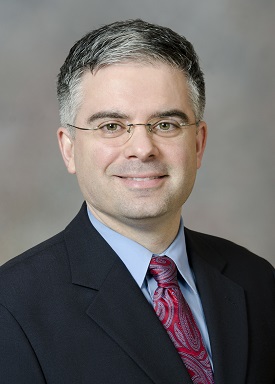Andrei Sdrulla, M.D., Ph.D.

Andrei Sdrulla, M.D., Ph.D.
Assistant Professor
Oregon Health & Science University
3181 S.W. Sam Jackson Park Road
Portland, OR 97239
Mail Code: L459
Phone: 503-494-7246
Research
Dr. Sdrulla specializes in the treatment of patients with complex, persistent pain in the spine, cancer pain, neuropathic pain (e.g., complex regional pain syndrome), shingles pain (post herpetic neuralgia) and post-surgical pain. He has advanced training in performing implantations of spinal cord stimulators for the treatment of unrelenting pain. Dr. Sdrulla strongly believes in the multidisciplinary, comprehensive approach to chronic pain championed here at Oregon Health &Science University.
Dr. Sdrulla's laboratory is focused on elucidating the mechanisms of spinal cord stimulation (SCS). SCS is a minimally invasive therapy used for the treatment of refractory neuropathic pain. It is believed that SCS mediates pain relief by electrical stimulation of Aβ fibers (Aβ-ES); however a detailed understanding of its biological basis is lacking, particularly concerning how it engages spinal cord nociceptive pathways. The long-term goals of Dr. Sdrulla's laboratory are to delineate the spinal mechanisms of SCS-induced analgesia in an effort to optimize its clinical implementation for the treatment of chronic pain. Current research is focused on dissecting the influence of Aβ-ES on defined neuronal microcircuits, and testing the role of a critical candidate subpopulation for the analgesic effects of Aβ-ES. The central hypothesis is that Aβ-ES achieves analgesia by inducing dynamic changes in specific populations of spinal cord neurons residing in the superficial dorsal horn (SDH). A combination of electrophysiological and imaging tools (two photon microscopy, optogenetics) are used to determine the extent to which a conditioning train of Aβ-ES modulates high-threshold (C-fiber) evoked activity of excitatory and inhibitory neurons and subpopulations in the SDH in vitro and in vivo. The proposed research is significant because a detailed understanding of how Aβ-ES engages the dorsal horn will provide a direct biological target for enhancements to SCS therapies with a sound mechanistic basis. This work will thus have direct translational relevance, as it may help optimize spinal cord stimulation programs and improve patient outcomes.
Research Team
Steve Sullivan, Ph.D.

Dr. Steve Sullivan works with Dr. Andrei Sdrulla studying the neuromodulatory and cellular mechanisms of pain relief achieved through electrical stimulation of the spinal cord. During his Ph.D. at the University of Minnesota, Steve characterized the release of the NMDA receptor coagonist D-serine and its physiological effects on retinal neurons. He was later awarded a National Science Foundation International Research Fellowship to conduct postdoctoral work at University College London, focusing on the molecular plasticity of fast excitatory transmission in the spinal cord that is associated with chronic pain.